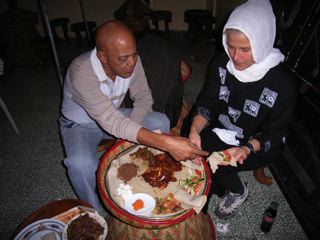 Last year when I was in Thailand, I met a man named Hussein.
He was from Yemen. I had only heard a little about Yemen because a friend of mine here in the States had
always wanted to go and raved about the architecture there. And, of course, it had been in the news with
the USS Cole attack. So, I didn't know much but I was intrigued and certainly impressed by how friendly,
well educated, and worldly this gentleman was. He also loved George Bush and this I found very odd.
But I listened because when someone from the Middle East likes George one has to wonder.
Basically, he felt the US had rid Iraq of a "butcher" and that pleased him.
I now know that Sadaam was quite popular in Yemen before the war because he helped the country financially
and always allowed the Yemeni people to work and study in Iraq.
Last year when I was in Thailand, I met a man named Hussein.
He was from Yemen. I had only heard a little about Yemen because a friend of mine here in the States had
always wanted to go and raved about the architecture there. And, of course, it had been in the news with
the USS Cole attack. So, I didn't know much but I was intrigued and certainly impressed by how friendly,
well educated, and worldly this gentleman was. He also loved George Bush and this I found very odd.
But I listened because when someone from the Middle East likes George one has to wonder.
Basically, he felt the US had rid Iraq of a "butcher" and that pleased him.
I now know that Sadaam was quite popular in Yemen before the war because he helped the country financially
and always allowed the Yemeni people to work and study in Iraq.
Upon my return to the US from Thailand, I received an email from my occasional travel companion, Carmen,
a German doctor that I had met in Mongolia in 2005. We had gone to Morocco together in 2006 but I was
never able to find an English keyboard at an internet cafe so I never wrote about that trip. Anyway,
Carmen said that she wanted us to go to Yemen that year. What a small world it is! and what
wonderful "coincidences" happen when you travel! I of course immediately agreed and then had the
pleasure of telling Hussein that, lo and behold, I would be coming to visit him!
After my initial excitement however, I began to worry. The media here and the State Department had
dreary warnings about Yemen. Not only was the country reported to have had killings of tourists,
they were nearly famous for kidnappings! There is ongoing conflict between the many tribes there
and the government. Yemen had only just recently become a republic in the 1990's after a long and
brutal civil war. The tribes kidnap tourists to try and pressure the government to build roads,
schools, hospitals or to provide satellite dishes. Part of me was actually rather curious about
being kidnapped as, reportedly, folks were treated quite well.
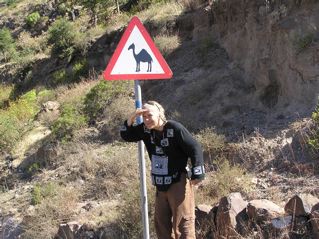 One cannot really travel alone in Yemen because of the roads,
limited mass transit and, of course, the potential danger. Therefore you have to go on a tour.
Carmen and I joined up with a Dutch company called Djoser that was leading a group of fifteen Germans, plus me.
I checked out another company here in the US and they do not go to Yemen due to the difficulty in obtaining a visa,
which I did have trouble getting. Unlike the Germans, I had to provide a health history, proof of health insurance,
and a letter from my doctor saying I was fit for travel. I don't know why; perhaps they have had bad experiences
with sick Americans.
One cannot really travel alone in Yemen because of the roads,
limited mass transit and, of course, the potential danger. Therefore you have to go on a tour.
Carmen and I joined up with a Dutch company called Djoser that was leading a group of fifteen Germans, plus me.
I checked out another company here in the US and they do not go to Yemen due to the difficulty in obtaining a visa,
which I did have trouble getting. Unlike the Germans, I had to provide a health history, proof of health insurance,
and a letter from my doctor saying I was fit for travel. I don't know why; perhaps they have had bad experiences
with sick Americans.
Not only did I work hard to get a visa, but I also had quite the challenge finding guide books about the place.
I ended up with a Lonely Planet guide for Yemen from 1996 and one of the Arabian Peninsula from 2004. After
overcoming all these challenges, I at last arrived in Frankfurt to meet the group and leave for Sana'a,
the capitol of Yemen. It turned out to be cheaper to fly from the US to Europe and then to Yemen, rather
than direct to Yemen. The tour included airfare from Frankfurt, three weeks accommodation, breakfast,
transportation, and all required military escorts. The total was about $2000 which I thought was quite reasonable (albeit more than I usually spend) given the circumstances. We flew on Yemenia airline and everything was the usual except one interesting detail: The screens continually showed where Mecca was with a picture of an airplane, an arrow and the distance. This is for the prayers which the Muslims do five times each day facing Mecca.
4:30am... ALLAHhhhhhhhh! The call to prayer blasts all over the
city from a multitude of PA systems. It is sunrise, I roll over and grab my earplugs... If lucky, my hotel room has a fan or AC running to drown out the deafening city
sounds. Every room has a symbol on the wall showing the way to Mecca
to pray. I pray for a little peace and quiet but also ponder this custom that has infiltrated the culture of Islamic countries completely. Can you imagine church bells ringing five times a day and everyone stopping what they are doing to pray? in some ways it might be nice to stop and notice, give thanks, pause, relax... but everyone in their own way and with an appreciation for Nature and the Planet and not just for a particular ideology that does not necessarily manifest itself in good works right here and now.
Somewhere between 6am and 8am, depending on the "program" for the day,
I get up. A few times we have had quite nice rooms. Usually the bed
is hard, the pillows hard, and everything is dilapidated, dusty and just
plain worn out. The showers usually have their own heater and
sometimes it works... dripping, hot and cold mixed... but wet and
refreshing. I brush the teeth with bottled water, put on one of the two
changes of clothes and just don't breathe too deeply.
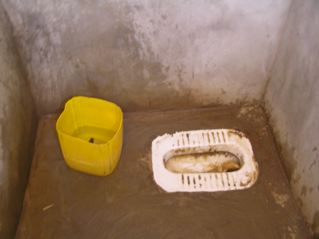 Breakfast for tourists... same ol, same ol... White roll-like bread, hard boiled
egg, processed triangle cheese, strawberry jam, Nescafe and orange juice from concentrate.
The Yemeni breakfast is a great dish called "fool"... spicy beans and flat bread...
I prefer this actually. They eat with their hands (tourists
get spoons.) Often they sit on the floor and we are put in chairs...
We get kleenex as napkins and every place has a sink with laundry
detergent powder to use as soap. The toilets are "Turkish" style:
a ceramic hole in the ground, and also doesn't have paper, just a spigot for water...
you rinse yourself and the ceramic hole in the floor... voila, a tree is saved.
Breakfast for tourists... same ol, same ol... White roll-like bread, hard boiled
egg, processed triangle cheese, strawberry jam, Nescafe and orange juice from concentrate.
The Yemeni breakfast is a great dish called "fool"... spicy beans and flat bread...
I prefer this actually. They eat with their hands (tourists
get spoons.) Often they sit on the floor and we are put in chairs...
We get kleenex as napkins and every place has a sink with laundry
detergent powder to use as soap. The toilets are "Turkish" style:
a ceramic hole in the ground, and also doesn't have paper, just a spigot for water...
you rinse yourself and the ceramic hole in the floor... voila, a tree is saved.
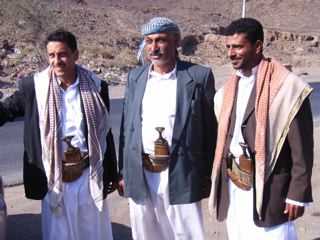 "Yala yala!!!" means a lot of things like "okay" or "let's go"
and the sixteen of us load into four landrovers with our drivers; Achmed,
Muhammad, Walid and Sale. I am lucky to be in the one with the guide,
Arif, so we get to ask him a lot of questions. Of course Carmen has to
translate everything since Arif doesn't speak English and I don't speak
German or Arabic! He is really funny and sweet and very knowledgable.
He loves his country and shares that enthusiasm.
"Yala yala!!!" means a lot of things like "okay" or "let's go"
and the sixteen of us load into four landrovers with our drivers; Achmed,
Muhammad, Walid and Sale. I am lucky to be in the one with the guide,
Arif, so we get to ask him a lot of questions. Of course Carmen has to
translate everything since Arif doesn't speak English and I don't speak
German or Arabic! He is really funny and sweet and very knowledgable.
He loves his country and shares that enthusiasm.
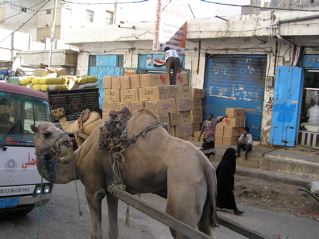 Trying to pull the cars out into the streets, wow, I don't know if I can describe these scenes. Even early, it is so packed, so noisy (mostly from the gazillion honking cars), you can barely hear yourself speak. There might be donkeys or camels pulling carts about. There are a million shops with everything from food, perfume, clothes, household goods, tools, hookahs, all packed into tiny shops lined up next to each other.
And then the streets are filled with more stalls or wheelbarrows or
folks just sitting there selling or watching.
Trying to pull the cars out into the streets, wow, I don't know if I can describe these scenes. Even early, it is so packed, so noisy (mostly from the gazillion honking cars), you can barely hear yourself speak. There might be donkeys or camels pulling carts about. There are a million shops with everything from food, perfume, clothes, household goods, tools, hookahs, all packed into tiny shops lined up next to each other.
And then the streets are filled with more stalls or wheelbarrows or
folks just sitting there selling or watching.
There are children everywhere and the women are completely covered in a black garment called an abeyaa.
The little boys play foosball or soccer in the streets after school.
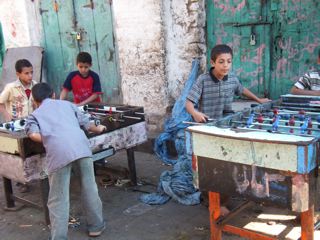 And Fridays are like our Sundays, so every internet cafe is full of kids playing video games! The young girls going to school wear green abeyaa uniforms and they don't have to have their faces covered. It is an ongoing argument whether or not the Quran says women must cover their faces or not. The south of Yemen is less strict than the north. The south was run by the Turks, the British, or the Soviets at different times. The north are more tribal and therefore more strict unless it is in the western part of the country which has more African influence, so the women there often have more colorful coverings. I have spoken with some women here and they say they prefer being covered; They feel more "comfortable". It apparently is more anonymous. They can look out and not be seen, and they get less harassment from the men.
And Fridays are like our Sundays, so every internet cafe is full of kids playing video games! The young girls going to school wear green abeyaa uniforms and they don't have to have their faces covered. It is an ongoing argument whether or not the Quran says women must cover their faces or not. The south of Yemen is less strict than the north. The south was run by the Turks, the British, or the Soviets at different times. The north are more tribal and therefore more strict unless it is in the western part of the country which has more African influence, so the women there often have more colorful coverings. I have spoken with some women here and they say they prefer being covered; They feel more "comfortable". It apparently is more anonymous. They can look out and not be seen, and they get less harassment from the men.
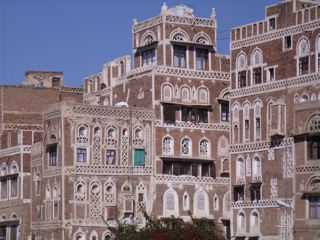 Yemen is mostly known for its amazing architecture and this changes depending on where you are. Sana'a is most famous because of its "Old City," an Unesco Heritage site. The city is packed inside a protective wall with the occasional arched gated entrances. The buildings are all a red color painted with intricate white stucco designs.
Yemen is mostly known for its amazing architecture and this changes depending on where you are. Sana'a is most famous because of its "Old City," an Unesco Heritage site. The city is packed inside a protective wall with the occasional arched gated entrances. The buildings are all a red color painted with intricate white stucco designs.
The windows, called takhrim, are made from alabaster and stained glass.
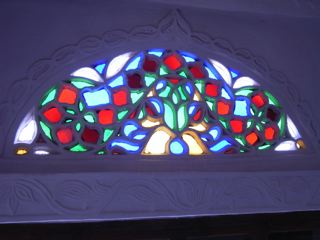 And then there are the doors; Every one seems different, either wooden and carved, or metal with bright colors and artistic overlays. The old cities always have the souqs or markets. These are all the shops already mentioned just crammed into an even smaller space. Tiny pathways either cobblestoned or still just dirt.
And then there are the doors; Every one seems different, either wooden and carved, or metal with bright colors and artistic overlays. The old cities always have the souqs or markets. These are all the shops already mentioned just crammed into an even smaller space. Tiny pathways either cobblestoned or still just dirt.
At one point in the trip, we went to the grand daddy of all souqs, Bayt al Faqih. Yes, you are probably pronouncing it properly... "Faqih, Faqih..." I thought our guide Arif was teasing me and I could not stop lauging. This is one of the oldest souqs in Yemen and happens every Friday as it has for hundreds of years. There are thousands of stalls here and so many people, you can barely walk or breathe.
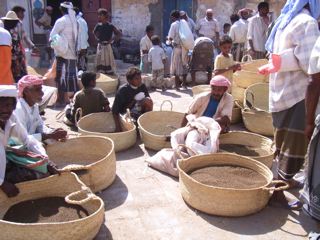 Each section has its own personality. The multicolored grains and spices in enormous woven baskets are weighed out with centuries old methods and tools. The food section has huge fryers filled with splattering oil frying batter covered whatevers. The textiles, the tools, the kitchen wares, the plastic shoes, the music... and the hooka shisha (their version of tobacco) pipes, which are much bigger than those I saw in Morocco, having inhalation tubes which are thicker and longer. And then the healers treating half naked men being suctioned with little plastic cups to get the "bad blood" out of them, or getting cut on their foreheads, or having Quarn prayers wrapped around their arms. The qat section is always the busiest...
Each section has its own personality. The multicolored grains and spices in enormous woven baskets are weighed out with centuries old methods and tools. The food section has huge fryers filled with splattering oil frying batter covered whatevers. The textiles, the tools, the kitchen wares, the plastic shoes, the music... and the hooka shisha (their version of tobacco) pipes, which are much bigger than those I saw in Morocco, having inhalation tubes which are thicker and longer. And then the healers treating half naked men being suctioned with little plastic cups to get the "bad blood" out of them, or getting cut on their foreheads, or having Quarn prayers wrapped around their arms. The qat section is always the busiest...
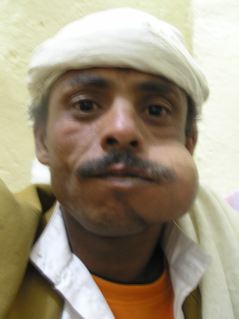 Now, as you you can probably guess, alcohol and drugs are not allowed here in a Muslim country. What they do instead is chew qat (pronounced "got") and woah! Is it ever the major event in Yemen! Evidently it also occurs in Ethiopia and Kenya. It is growing everywhere, sold everywhere, and chewed daily. They say it has a mild stimulating effect but everyone looks totally stoned on it. They buy bags of this stuff starting at around two in the afternoon and then sit around and chew until one side of the cheek is packed with it. It is a status symbol to have the biggest cheek as it indicates affluence and stamina. Evidently, qat is a real problem here for the economy as the men will spend up to half of their meager income on qat, not to mention how little work gets done while sitting around chewing. In addition, most of the available water goes to grow the qat trees in this desert country, creating a dangerous water shortage.
Now, as you you can probably guess, alcohol and drugs are not allowed here in a Muslim country. What they do instead is chew qat (pronounced "got") and woah! Is it ever the major event in Yemen! Evidently it also occurs in Ethiopia and Kenya. It is growing everywhere, sold everywhere, and chewed daily. They say it has a mild stimulating effect but everyone looks totally stoned on it. They buy bags of this stuff starting at around two in the afternoon and then sit around and chew until one side of the cheek is packed with it. It is a status symbol to have the biggest cheek as it indicates affluence and stamina. Evidently, qat is a real problem here for the economy as the men will spend up to half of their meager income on qat, not to mention how little work gets done while sitting around chewing. In addition, most of the available water goes to grow the qat trees in this desert country, creating a dangerous water shortage.
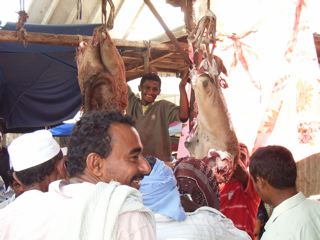 After the qat section of the souq we encounter the grossest part of all, the meat department. Here, chains hang down with partially skinned carcasses dangling. There is a calf head, eyes open, below its body. Then, the thighs of a camel (which they do eat here), or chickens sqawking, tied together watching their brothers be stripped and quartered. All around the ground the entrails are being devoured by scrawny, filthy, ravenous dogs and cats, growling and hissing with eyes flitting about. I really don't mind this open slaughtering.
After the qat section of the souq we encounter the grossest part of all, the meat department. Here, chains hang down with partially skinned carcasses dangling. There is a calf head, eyes open, below its body. Then, the thighs of a camel (which they do eat here), or chickens sqawking, tied together watching their brothers be stripped and quartered. All around the ground the entrails are being devoured by scrawny, filthy, ravenous dogs and cats, growling and hissing with eyes flitting about. I really don't mind this open slaughtering.
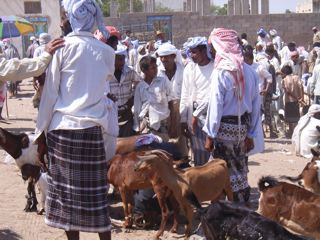 In fact, I think if you are going to eat these animals, which I do,
you should know and appreciate where your meal comes from and give
thanks to that animal for giving its life.
Soon after the butcher section, we get to see the live animal section.
Mostly cows, goats, chickens, some donkeys and camels. And speaking of
camels, they are often attached to a mill of sorts where it walks round
and round to make cooking oil. Ah Faqih, Faqih... what an amazing place.
Sadly, we also saw many disabled children being rolled around in wheelbarrows
to beg for money. The wheelbarrow: the main way to get around in the souq.
In fact, I think if you are going to eat these animals, which I do,
you should know and appreciate where your meal comes from and give
thanks to that animal for giving its life.
Soon after the butcher section, we get to see the live animal section.
Mostly cows, goats, chickens, some donkeys and camels. And speaking of
camels, they are often attached to a mill of sorts where it walks round
and round to make cooking oil. Ah Faqih, Faqih... what an amazing place.
Sadly, we also saw many disabled children being rolled around in wheelbarrows
to beg for money. The wheelbarrow: the main way to get around in the souq.
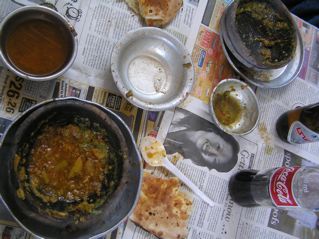 In Sana'a we also got to try our first typical meal here, the salta. It is like a stew cooked in a wrought iron pot over an incredibly high hot flame. Restaurants here are usually open to the street and packed with men. Those that serve families have private curtained rooms so that the women can uncover their faces in order to shovel food in. Other common meal choices besides the salta are roasted chicken, lamb, and camel, lentils, beans, rice, and even pasta with a small blob of tomato paste, and a dish that is a thin layer of eggs on the bottom of a pan, and of course, bread. They have many kinds of bread here but the most common is a large flat one that is easily folded to be able to scoop up the rest of the meal. Meal times are never peaceful.
In Sana'a we also got to try our first typical meal here, the salta. It is like a stew cooked in a wrought iron pot over an incredibly high hot flame. Restaurants here are usually open to the street and packed with men. Those that serve families have private curtained rooms so that the women can uncover their faces in order to shovel food in. Other common meal choices besides the salta are roasted chicken, lamb, and camel, lentils, beans, rice, and even pasta with a small blob of tomato paste, and a dish that is a thin layer of eggs on the bottom of a pan, and of course, bread. They have many kinds of bread here but the most common is a large flat one that is easily folded to be able to scoop up the rest of the meal. Meal times are never peaceful.
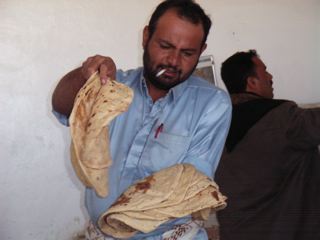 The places are packed, everyone yelling and running around, with the waiter (if you can call him that) throwing pans of food onto the tables, usually with a cigarette hanging out of his mouth. My favorite time was when Carmen ordered fish and bam! it is thrown head, tail, and all, right onto the table. I guess you have to order a plate, too, if you really want one.
The places are packed, everyone yelling and running around, with the waiter (if you can call him that) throwing pans of food onto the tables, usually with a cigarette hanging out of his mouth. My favorite time was when Carmen ordered fish and bam! it is thrown head, tail, and all, right onto the table. I guess you have to order a plate, too, if you really want one.
To drink, you usually order bottled water. I have to say that plastic has not served this country well, and really, maybe not even the world... There is so much plastic trash, bottles and bags, around here it looks like there are plastic bag bushes and bottled earth. And, of course, one can always order Coke. In fact, I even found Mountain Dew! There is also alcohol-free beer, but why bother? And after every meal they drink tea. The tea is good but it is disappointing that a country that was famous for its coffee (Mocha came from here) now only serves Nescafe. I have witnessed this, sadly, all over the world... Amazing beans and Nescafe has ruined them and sold this crap back to a poor country at a profit. Yemen is also famous for its honey. The bees feed primarily on Acacia trees and I was told that some honey can sell for $300 a kilo! We only got to try honey on a delicious desert that is like sweet bread drenched in it.
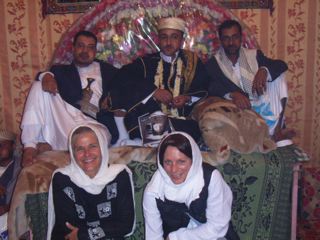 Our first night in Sanaa we were spontaneously invited to a Bachelor party. Here, weddings, like just about everything, the men and women do separately. In fact, it is difficult to meet someone to marry. Usually the mothers arrange things. Inviting us, the men would put their hands on their heads which means, "we so welcome you, we would stand on our heads!" The men greet each other with multiple kisses on the cheeks and they frequently hold hands when walking down the street. Occasionally we saw what was obviously a married couple holding hands but, in general, men and women do not touch. There were two or three hundred men in the tent.
Our first night in Sanaa we were spontaneously invited to a Bachelor party. Here, weddings, like just about everything, the men and women do separately. In fact, it is difficult to meet someone to marry. Usually the mothers arrange things. Inviting us, the men would put their hands on their heads which means, "we so welcome you, we would stand on our heads!" The men greet each other with multiple kisses on the cheeks and they frequently hold hands when walking down the street. Occasionally we saw what was obviously a married couple holding hands but, in general, men and women do not touch. There were two or three hundred men in the tent.
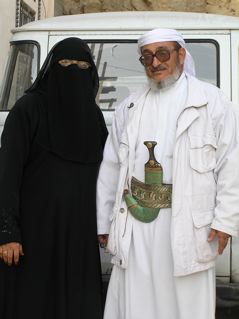 Carmen and I were the only women, but evidently we are not really considered women, we are foreigners. The groom was in the back of the tent, seated on an elaborately decorated throne. The rest of the men were seated around the tent on pillows chewing qat.
Carmen and I were the only women, but evidently we are not really considered women, we are foreigners. The groom was in the back of the tent, seated on an elaborately decorated throne. The rest of the men were seated around the tent on pillows chewing qat.
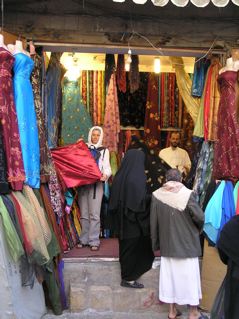 They played music for us on the traditional ud, which is like a big round guitar, and they danced. The most popular dance is done with the jambiyaa, a curved knife worn daily by most men in Yemen on the front of the body held by a colorful woven belt. The covers for these knives used to be made from rhinoceros horn until it almost caused their extinction, so now the covers are made from lime green or brown chiseled leather. The men wear a long white shirt down to their ankles and a western style coat jacket that is a carry over from British influence. They also wear a traditional scarf tied in a variety of ways on their heads or around their shoulders. At weddings, women wear long, bright beaded gowns, gold jewelry and lots of make up... All covered up by the black abeyya if there are any men around.
They played music for us on the traditional ud, which is like a big round guitar, and they danced. The most popular dance is done with the jambiyaa, a curved knife worn daily by most men in Yemen on the front of the body held by a colorful woven belt. The covers for these knives used to be made from rhinoceros horn until it almost caused their extinction, so now the covers are made from lime green or brown chiseled leather. The men wear a long white shirt down to their ankles and a western style coat jacket that is a carry over from British influence. They also wear a traditional scarf tied in a variety of ways on their heads or around their shoulders. At weddings, women wear long, bright beaded gowns, gold jewelry and lots of make up... All covered up by the black abeyya if there are any men around.
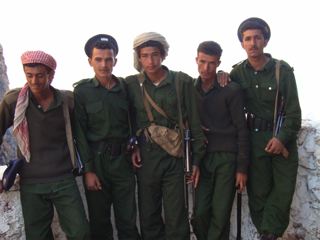 After Sana'a, we headed North. The trip to the city of Sada had been cancelled due to tribal conflicts and so we were only going as far as Shahara. On the way we stopped at a few villages. You could immediately see the difference in the architecture: much simpler mud buildings but still many stories tall to house the different parts of a family. The kitchen area downstairs, then the women's quarters, then the extended family and finally at the very top is the qat chewing room. This leg of the journey required a military escort provided by the government. Our boys were ages 14 to 18, barely had facial hair and were carrying Kalishnikovs and chewing qat. "Guns and qat" became the mantra of this trip. At the base of Shahara we had to switch vehicles and use the local tribes' Toyota trucks, not only to support the tribe, but also because only these Toyotas could make it up the road! Now I have been on some rough terrain in my time but I have never been on roads like these: Thin, treacherous, and steep, with boulders and rocks... terrifying! We were told that Toyota designed these trucks specifically for this road and then made commercials about them! We rode in the back of the trucks with our military boys bouncing around with the butts of guns in our sides... And it was worth it.
After Sana'a, we headed North. The trip to the city of Sada had been cancelled due to tribal conflicts and so we were only going as far as Shahara. On the way we stopped at a few villages. You could immediately see the difference in the architecture: much simpler mud buildings but still many stories tall to house the different parts of a family. The kitchen area downstairs, then the women's quarters, then the extended family and finally at the very top is the qat chewing room. This leg of the journey required a military escort provided by the government. Our boys were ages 14 to 18, barely had facial hair and were carrying Kalishnikovs and chewing qat. "Guns and qat" became the mantra of this trip. At the base of Shahara we had to switch vehicles and use the local tribes' Toyota trucks, not only to support the tribe, but also because only these Toyotas could make it up the road! Now I have been on some rough terrain in my time but I have never been on roads like these: Thin, treacherous, and steep, with boulders and rocks... terrifying! We were told that Toyota designed these trucks specifically for this road and then made commercials about them! We rode in the back of the trucks with our military boys bouncing around with the butts of guns in our sides... And it was worth it.
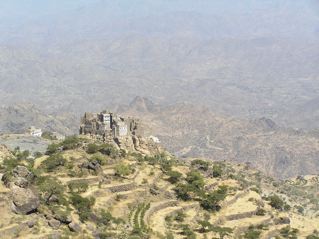 Shahara is a village nearly three thousand meters up a mountain. it is common for the villages to be on the mountains, one, it is easier to protect, and two, it frees up the mountain sides and valleys for planting in extensive, amazing terraces. Through the years, its location helped it to be a tribal base holding out against many invaders until the advent of the airplane... Then it got bombed into semi-submission. The main attraction here is the last crossing of what used to be a three tiered stone bridge connecting the two mountains.
Shahara is a village nearly three thousand meters up a mountain. it is common for the villages to be on the mountains, one, it is easier to protect, and two, it frees up the mountain sides and valleys for planting in extensive, amazing terraces. Through the years, its location helped it to be a tribal base holding out against many invaders until the advent of the airplane... Then it got bombed into semi-submission. The main attraction here is the last crossing of what used to be a three tiered stone bridge connecting the two mountains.
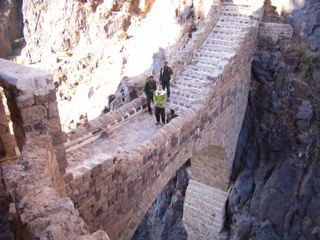 It reminds you of an Indiana Jones movie and puts "Vertigo" to shame! Truly, it is an engineering miracle considering how ancient it is. Up here, as in every village, are cisterns that collect rainwater. The women, in their black garb, come daily to collect buckets of water which they filter with old T-shirts, then walk with brightly colored containers balanced on their heads over steep mountain paths. The accommodation here are called funduq, which are really just old multistoried homes converted into hotels. The men and women are separated and sleep on the floor, dorm style.
It reminds you of an Indiana Jones movie and puts "Vertigo" to shame! Truly, it is an engineering miracle considering how ancient it is. Up here, as in every village, are cisterns that collect rainwater. The women, in their black garb, come daily to collect buckets of water which they filter with old T-shirts, then walk with brightly colored containers balanced on their heads over steep mountain paths. The accommodation here are called funduq, which are really just old multistoried homes converted into hotels. The men and women are separated and sleep on the floor, dorm style.
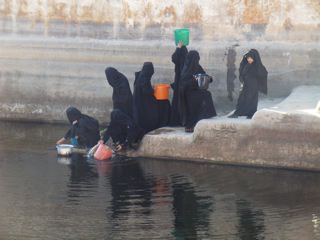 In all of these villages we visit, we are met by throngs of children yelling "kalem, kalem!" (pen, pen) or "sura, sura" (photo, photo). Of all the places I've travelled I have never encountered a people so eager to have their pictures taken (except the older women). And all they really want is to have you show it to them. Unfortunately, some are now figuring out that they can ask for money. In one village, again at the tippy top of a mountain, a woman dressed in black and surrounded by children waved Carmen and I over to her. We were shocked to have been approached by a woman! Through gestures and my little Instant Arabic book, we had a wonderful conversation about religion, our countries, our families and customs. She was so open she uncovered her face and even showed us scars on her belly! She then showed me how to properly wrap my head scarf so it would completely cover my face.
In all of these villages we visit, we are met by throngs of children yelling "kalem, kalem!" (pen, pen) or "sura, sura" (photo, photo). Of all the places I've travelled I have never encountered a people so eager to have their pictures taken (except the older women). And all they really want is to have you show it to them. Unfortunately, some are now figuring out that they can ask for money. In one village, again at the tippy top of a mountain, a woman dressed in black and surrounded by children waved Carmen and I over to her. We were shocked to have been approached by a woman! Through gestures and my little Instant Arabic book, we had a wonderful conversation about religion, our countries, our families and customs. She was so open she uncovered her face and even showed us scars on her belly! She then showed me how to properly wrap my head scarf so it would completely cover my face.
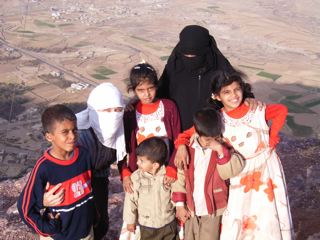 When her son-in-law showed up, she quickly covered up and it was noticeable how she withdrew. We had gotten to have many conversations with men about the covering of women: One group of college boys told us that they felt women being covered helped the men to "control themselves." During this conversation they also said that Muslims are adamantly against violence and do not agree with religious extremists. They accept all religious books and prophets which are said to have come from God, but, of course, believe that the Quran and Muhammad are the final, definitive ones. When talking about politics, they are able to separate out a people from its government, that was why it was okay for me to be from the U.S. They don't really like their own president as they believe he is not taking the country forward. Their president has a difficult time finding harmony between all the tribes and, as is so often the case, he steals or wastes a lot of money, for example, on a forty million dollar mosque rather than on schools or hospitals.
When her son-in-law showed up, she quickly covered up and it was noticeable how she withdrew. We had gotten to have many conversations with men about the covering of women: One group of college boys told us that they felt women being covered helped the men to "control themselves." During this conversation they also said that Muslims are adamantly against violence and do not agree with religious extremists. They accept all religious books and prophets which are said to have come from God, but, of course, believe that the Quran and Muhammad are the final, definitive ones. When talking about politics, they are able to separate out a people from its government, that was why it was okay for me to be from the U.S. They don't really like their own president as they believe he is not taking the country forward. Their president has a difficult time finding harmony between all the tribes and, as is so often the case, he steals or wastes a lot of money, for example, on a forty million dollar mosque rather than on schools or hospitals.
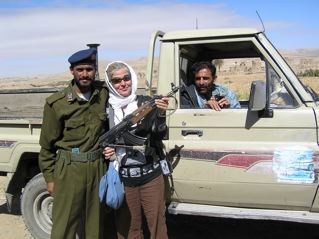 After Shahara, we headed east to Marib. Again, we needed a military escort due to conflict between the tribes and the government. We passed so many military checkpoints I lost count. These guys love to hand you their guns and take pictures with you! It also looks really strange to see them all with their old fashioned weapons and then a cell phone out in the middle of nowhere. They code the cities: Green = OK; Yellow = be careful and stay near the hotel; Red = danger, can't leave the hotel. Marib was a Red zone, so we had to have the police with us to tour the city. Here, there are ancient temples over two thousand years old.
After Shahara, we headed east to Marib. Again, we needed a military escort due to conflict between the tribes and the government. We passed so many military checkpoints I lost count. These guys love to hand you their guns and take pictures with you! It also looks really strange to see them all with their old fashioned weapons and then a cell phone out in the middle of nowhere. They code the cities: Green = OK; Yellow = be careful and stay near the hotel; Red = danger, can't leave the hotel. Marib was a Red zone, so we had to have the police with us to tour the city. Here, there are ancient temples over two thousand years old.
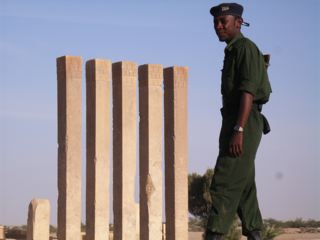 Some believe the Queen of Sheba (also known as Belquis) came from here. The temples are also known as the Sun and Moon temples and are covered with Sabaean text.
Some believe the Queen of Sheba (also known as Belquis) came from here. The temples are also known as the Sun and Moon temples and are covered with Sabaean text.
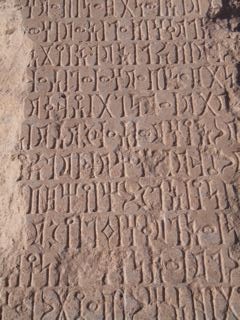 There is also an old dam which was built like the Panama canal lock system. Nearby there is a new dam which reportedly doesn't get used much, again, due to political conflict. It is such a waste of water just sitting there evaporating. The old city of Marib is abandoned, the mud houses decaying, eerie and mystical in the setting sun with the far off sound of the fourth call to prayer. We stayed at a hotel called the Land of Two Paradises and, believe me, if you need two paradises what is up with the first one? Filthy, buggy, hot and miserable. It was a blessing to get up at 4am to cross the Ramlat as-Sab'atayn desert... This time with a Bedouin escort.
There is also an old dam which was built like the Panama canal lock system. Nearby there is a new dam which reportedly doesn't get used much, again, due to political conflict. It is such a waste of water just sitting there evaporating. The old city of Marib is abandoned, the mud houses decaying, eerie and mystical in the setting sun with the far off sound of the fourth call to prayer. We stayed at a hotel called the Land of Two Paradises and, believe me, if you need two paradises what is up with the first one? Filthy, buggy, hot and miserable. It was a blessing to get up at 4am to cross the Ramlat as-Sab'atayn desert... This time with a Bedouin escort.
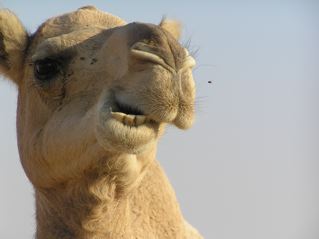 We were told we needed the escort because there were still land mines from the civil war and the Bedouins knew where they were. It must have been a wide free range, though, since we drove like crazy and seemed to have no particular path other than East. We stopped and ate with a family in their tents and hung with the camels a bit. And then we went for a crazy dune ride which I was the only girl brave (or stupid) enough to do. It is trance-inducing in the desert and easy to become disoriented with only sand, mirages, dots of camels on the horizon and the dust stirred up by the land rovers.
We were told we needed the escort because there were still land mines from the civil war and the Bedouins knew where they were. It must have been a wide free range, though, since we drove like crazy and seemed to have no particular path other than East. We stopped and ate with a family in their tents and hung with the camels a bit. And then we went for a crazy dune ride which I was the only girl brave (or stupid) enough to do. It is trance-inducing in the desert and easy to become disoriented with only sand, mirages, dots of camels on the horizon and the dust stirred up by the land rovers.
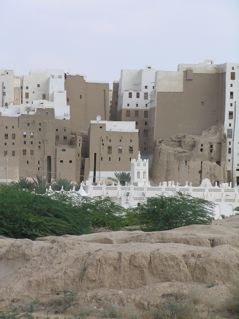 After the desert you end up in Wadi Hadramawt. Wadi means riverbed and usually has a river running through it, although most we saw had no water. There is a brief rainy season in the summer. But the valley is greener, with palm trees, acacia and much agriculture. A common sight are the girls covered in black and perhaps with the local style straw hat in the shape of a witch's hat either working in the fields or leading a herd of goats around. This area is one of the more affluent governates due to its fertility. Even the people are heavier! The men wear sarongs from the Indonesian influence. Because of all the trade happening at the nearby ports many people emigrated and then eventually returned here. You can also see the Indonesian influence in the bright colorful flowers painted around the windows. But the most noticeable area here is the village of Shibam, also known as the "Manhattan of the Desert." It is called this because shooting up out of the landscape are a patch of tall, thin, tightly packed mud "skyscrapers." Although the multistoried building is common in Yemen, for some reason here, it really excelled. The inhabitants often don't even go down to the street to get around but instead cross over the roofs! At times you will see blue eyes beaming out amongst the Arab faces. They lock with ours and smile at our inevitable genetic connection. Because of all the trade here, Yemen has been exposed to many cultures throughout its history. The Sunni and Shia seem to worship together in peace, there are still a few Jewish communities, remnants of Soviet style block houses remain, and we even saw a church.
After the desert you end up in Wadi Hadramawt. Wadi means riverbed and usually has a river running through it, although most we saw had no water. There is a brief rainy season in the summer. But the valley is greener, with palm trees, acacia and much agriculture. A common sight are the girls covered in black and perhaps with the local style straw hat in the shape of a witch's hat either working in the fields or leading a herd of goats around. This area is one of the more affluent governates due to its fertility. Even the people are heavier! The men wear sarongs from the Indonesian influence. Because of all the trade happening at the nearby ports many people emigrated and then eventually returned here. You can also see the Indonesian influence in the bright colorful flowers painted around the windows. But the most noticeable area here is the village of Shibam, also known as the "Manhattan of the Desert." It is called this because shooting up out of the landscape are a patch of tall, thin, tightly packed mud "skyscrapers." Although the multistoried building is common in Yemen, for some reason here, it really excelled. The inhabitants often don't even go down to the street to get around but instead cross over the roofs! At times you will see blue eyes beaming out amongst the Arab faces. They lock with ours and smile at our inevitable genetic connection. Because of all the trade here, Yemen has been exposed to many cultures throughout its history. The Sunni and Shia seem to worship together in peace, there are still a few Jewish communities, remnants of Soviet style block houses remain, and we even saw a church.
 Saying farewell to Wadi Hadramawt, we headed south toward the Indian Ocean to the port of Mukalla. I haven't much good to say about this place... It was crowded, noisy and dirty. We were supposed to head from here back West along the coast to a fairly good sized city named Ataq. However, it became a Red Zone and was cancelled. This turned out to be a blessing. We went instead to a place called Bir Ali. Paradise! We stayed in mud huts that were open facing the pristine turquoise water and white sandy beach. It was a much needed pause in this fast-paced tour. Of course there were no locals to be seen as in bathing suits we might as well have been naked! The Yemeni people evidently fish but rarely swim and, needless to say, the women, if they were to swim would have to do so at a private pool. Speaking of which, I did go to a hammam (a bath house) once. I was the only foreigner and the center of attention. The hammams are like caves with warm water coming out at certain areas that the women gather around to scrub and wash their hair. It was a nice, albeit unusual way to finally meet the women here!
Saying farewell to Wadi Hadramawt, we headed south toward the Indian Ocean to the port of Mukalla. I haven't much good to say about this place... It was crowded, noisy and dirty. We were supposed to head from here back West along the coast to a fairly good sized city named Ataq. However, it became a Red Zone and was cancelled. This turned out to be a blessing. We went instead to a place called Bir Ali. Paradise! We stayed in mud huts that were open facing the pristine turquoise water and white sandy beach. It was a much needed pause in this fast-paced tour. Of course there were no locals to be seen as in bathing suits we might as well have been naked! The Yemeni people evidently fish but rarely swim and, needless to say, the women, if they were to swim would have to do so at a private pool. Speaking of which, I did go to a hammam (a bath house) once. I was the only foreigner and the center of attention. The hammams are like caves with warm water coming out at certain areas that the women gather around to scrub and wash their hair. It was a nice, albeit unusual way to finally meet the women here!
The next city, Aden, was the biggest port in the past and is now the winter capitol. It is a big fairly modern bustling city. We even went to a mall and I had to have a slice at the Pizza Hut. Pizza Hut and Kentucky Fried Chicken were the only franchises I had seen here. Actually, I don't like that franchises have not only taken over our country but are now attempting to take over the rest of the world. What a shame it will be if the entire planet looks like an Anywhere, USA strip mall! However, I will admit that the slice I had there was much more familiar than the Yemeni pizza I tried which did not use tomato sauce and instead had some weird sweet sauce! It was here in Aden that I again noticed a cemetery that had no grave markers. I came to find out that in the Muslim religion, a person is to be buried but not marked so that all are remembered equally and humbly in death.
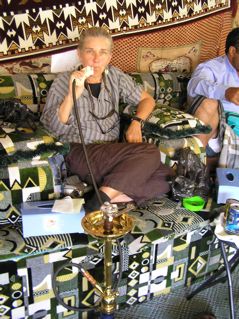 After Aden we headed North toward Sana'a and stopped in Taiz. Taiz is a big old loud dirty city in the middle of a valley surrounded by mountains. We stayed here three nights using it as a hub to visit other nearby villages and, I must say, it grows on you. It was here that I finally decided to try the qat. I figured it was the core cultural occurrence here and I should know why. So, I bought a $10 small bag of pre-picked leaves. Taiz is known for having the best qat in the country... But $10?! That is a lot of money here. Two hundred Rial is a (US) dollar. The average income is about $350 per year! Granted, gas costs about fifty cents a gallon and a meal about $3.00.
After Aden we headed North toward Sana'a and stopped in Taiz. Taiz is a big old loud dirty city in the middle of a valley surrounded by mountains. We stayed here three nights using it as a hub to visit other nearby villages and, I must say, it grows on you. It was here that I finally decided to try the qat. I figured it was the core cultural occurrence here and I should know why. So, I bought a $10 small bag of pre-picked leaves. Taiz is known for having the best qat in the country... But $10?! That is a lot of money here. Two hundred Rial is a (US) dollar. The average income is about $350 per year! Granted, gas costs about fifty cents a gallon and a meal about $3.00.
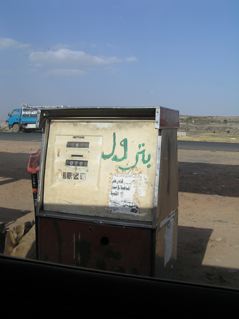 But it just doesn't add up. It turned out I couldn't finish my bag although it is the usual amount for an evening. You can get cheaper qat especially if the leaves are still on the branches. Anyway, we went to a qat chewing parlor. It was decorated with plush couches and pillows, furry walls, many-colored fabrics and had lots of hookah scattered about. The guide, Arif, showed me what I was supposed to do: Basically, stick the leaves in one of your cheeks and chew. It tastes AWFUL! Bitter and nasty... But I kept chewing, determined to see what was up with this stuff. Arif suggested I drink a Coke with it to help it go down... You don't swallow the bulk of it, just the juices. That is why the bulk builds up as a big wad in your cheek. Then, I tried to smoke the shisha to help with the horrible taste. I kept chewing and chewing and chewing... And nothing ever happened. Arif told me it could take up to three hours to feel the effect, and the "effect" is described as a "push." They say it is a bit of a stimulant but I never felt anything and, honestly, mostly saw people just sit around and look zoned out. I made it about an hour and a half... And I just couldn't take anymore... It was too boring just sitting there. I see why it is destroying the economy: what a complete waste of time.
But it just doesn't add up. It turned out I couldn't finish my bag although it is the usual amount for an evening. You can get cheaper qat especially if the leaves are still on the branches. Anyway, we went to a qat chewing parlor. It was decorated with plush couches and pillows, furry walls, many-colored fabrics and had lots of hookah scattered about. The guide, Arif, showed me what I was supposed to do: Basically, stick the leaves in one of your cheeks and chew. It tastes AWFUL! Bitter and nasty... But I kept chewing, determined to see what was up with this stuff. Arif suggested I drink a Coke with it to help it go down... You don't swallow the bulk of it, just the juices. That is why the bulk builds up as a big wad in your cheek. Then, I tried to smoke the shisha to help with the horrible taste. I kept chewing and chewing and chewing... And nothing ever happened. Arif told me it could take up to three hours to feel the effect, and the "effect" is described as a "push." They say it is a bit of a stimulant but I never felt anything and, honestly, mostly saw people just sit around and look zoned out. I made it about an hour and a half... And I just couldn't take anymore... It was too boring just sitting there. I see why it is destroying the economy: what a complete waste of time.
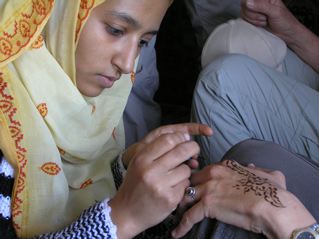 During our stay in Taiz we visited quite a few villages. One was on top of Jebal Saber, the local mountain. Here the women wear bright wraps, often have their faces uncovered and do Henna on the hands and feet of the tourists. It is said that the women run quite a few of the businesses and have stayed more open because they could sell more goods to the military and men at the bottom of the mountain than their men could. We also went to Gibla where there was a beautiful old mosque, elaborately painted inside, and had been built by a queen who ruled there until she was ninety two! Another village, near the Red Sea, was called Khokah.
During our stay in Taiz we visited quite a few villages. One was on top of Jebal Saber, the local mountain. Here the women wear bright wraps, often have their faces uncovered and do Henna on the hands and feet of the tourists. It is said that the women run quite a few of the businesses and have stayed more open because they could sell more goods to the military and men at the bottom of the mountain than their men could. We also went to Gibla where there was a beautiful old mosque, elaborately painted inside, and had been built by a queen who ruled there until she was ninety two! Another village, near the Red Sea, was called Khokah.
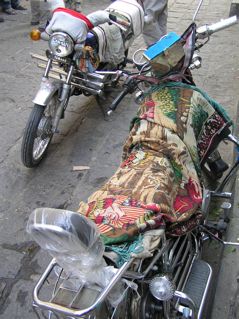 The beach was disgusting with thousands of dead crabs, a dead dog and a dead flamingo. It was rather creepy but in keeping with the "Wild West" feel to the place, we stumbled upon what looked like a Harley convention, except the bikes were all Hondas... All decorated with sheep skins, rugs, bells, feathers, lights and beads.
The beach was disgusting with thousands of dead crabs, a dead dog and a dead flamingo. It was rather creepy but in keeping with the "Wild West" feel to the place, we stumbled upon what looked like a Harley convention, except the bikes were all Hondas... All decorated with sheep skins, rugs, bells, feathers, lights and beads.
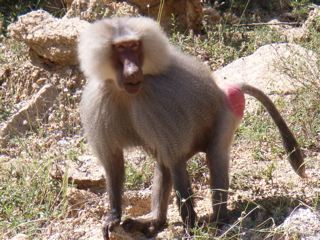 And just when you think you've seen it all, woah! We found what was called a "national park" and it had Yosemite-like cliffs, forests and oh my Allah, baboons!
And just when you think you've seen it all, woah! We found what was called a "national park" and it had Yosemite-like cliffs, forests and oh my Allah, baboons!
Our three weeks were coming to an end and, I must say, I was feeling a little overwhelmed with this whirlwind tour. It seemed like we had seen every single village in the entire country... But there were even more surprises awaiting me. Our final village before returning to Sana'a was Manakah, again in a funduq on a sheer mountain side nearly at the peak. What was special about this place was the family that ran it: A man and his sons (women hidden at home again, darn it), ran this place. Not only did they cook and serve these amazing meals, but they danced and played some of the best music I had heard in Yemen. Now granted, you can't beat Abou Bakr who is the number one singer from here, but next had to be this family. They played the ud and drums, but what was most astonishing was how loud they could clap and, even more than that, was the whistling! And then they would get up and dance. They did the jambiyaa (knife) dance, a dance with rifles, and one with their huge long sleeves of their white dresses. It reminded you almost of the Sufi dancers how they would just keep moving faster and faster and stare off into space as if in a trance. We all got to join in and again it made me wonder what the women do. I loved this family. They were so sweet and open. One of the boys asked me if America was in Asia, Africa or Europe. It was so refreshing to meet someone with no preconceived ideas about us.
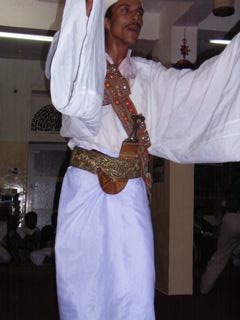 I had met so many wonderful people here, and not just from Yemen. One couple on the tour was a German man and his Iranian wife. He had converted to Islam in order to marry her. They go to Iran every year to see her family. And I met a man from Jordan who said that Jordan was so progressive that I could just fly in, rent a car and drive wherever I wanted to. I visited a mental hospital, an autism clinic (since I am a psychiatric nurse) and spent wonderful afternoons with my friend Hussein's family. Everywhere, I was enthusiastically welcomed and often showered with gifts. I thought back on my initial reservations for visiting this country, sighed, and felt very grateful that I had not succumbed to the propaganda we are fed here about the Middle East. I will continue to explore this area, so rich in history and passion, and to try to bridge the great gap that governments and politics create when in truth, as travel always teaches, we are all so alike.
I had met so many wonderful people here, and not just from Yemen. One couple on the tour was a German man and his Iranian wife. He had converted to Islam in order to marry her. They go to Iran every year to see her family. And I met a man from Jordan who said that Jordan was so progressive that I could just fly in, rent a car and drive wherever I wanted to. I visited a mental hospital, an autism clinic (since I am a psychiatric nurse) and spent wonderful afternoons with my friend Hussein's family. Everywhere, I was enthusiastically welcomed and often showered with gifts. I thought back on my initial reservations for visiting this country, sighed, and felt very grateful that I had not succumbed to the propaganda we are fed here about the Middle East. I will continue to explore this area, so rich in history and passion, and to try to bridge the great gap that governments and politics create when in truth, as travel always teaches, we are all so alike.
 Last year when I was in Thailand, I met a man named Hussein.
He was from Yemen. I had only heard a little about Yemen because a friend of mine here in the States had
always wanted to go and raved about the architecture there. And, of course, it had been in the news with
the USS Cole attack. So, I didn't know much but I was intrigued and certainly impressed by how friendly,
well educated, and worldly this gentleman was. He also loved George Bush and this I found very odd.
But I listened because when someone from the Middle East likes George one has to wonder.
Basically, he felt the US had rid Iraq of a "butcher" and that pleased him.
I now know that Sadaam was quite popular in Yemen before the war because he helped the country financially
and always allowed the Yemeni people to work and study in Iraq.
Last year when I was in Thailand, I met a man named Hussein.
He was from Yemen. I had only heard a little about Yemen because a friend of mine here in the States had
always wanted to go and raved about the architecture there. And, of course, it had been in the news with
the USS Cole attack. So, I didn't know much but I was intrigued and certainly impressed by how friendly,
well educated, and worldly this gentleman was. He also loved George Bush and this I found very odd.
But I listened because when someone from the Middle East likes George one has to wonder.
Basically, he felt the US had rid Iraq of a "butcher" and that pleased him.
I now know that Sadaam was quite popular in Yemen before the war because he helped the country financially
and always allowed the Yemeni people to work and study in Iraq.
 One cannot really travel alone in Yemen because of the roads,
limited mass transit and, of course, the potential danger. Therefore you have to go on a tour.
Carmen and I joined up with a Dutch company called Djoser that was leading a group of fifteen Germans, plus me.
I checked out another company here in the US and they do not go to Yemen due to the difficulty in obtaining a visa,
which I did have trouble getting. Unlike the Germans, I had to provide a health history, proof of health insurance,
and a letter from my doctor saying I was fit for travel. I don't know why; perhaps they have had bad experiences
with sick Americans.
One cannot really travel alone in Yemen because of the roads,
limited mass transit and, of course, the potential danger. Therefore you have to go on a tour.
Carmen and I joined up with a Dutch company called Djoser that was leading a group of fifteen Germans, plus me.
I checked out another company here in the US and they do not go to Yemen due to the difficulty in obtaining a visa,
which I did have trouble getting. Unlike the Germans, I had to provide a health history, proof of health insurance,
and a letter from my doctor saying I was fit for travel. I don't know why; perhaps they have had bad experiences
with sick Americans.
 Breakfast for tourists... same ol, same ol... White roll-like bread, hard boiled
egg, processed triangle cheese, strawberry jam, Nescafe and orange juice from concentrate.
The Yemeni breakfast is a great dish called "fool"... spicy beans and flat bread...
I prefer this actually. They eat with their hands (tourists
get spoons.) Often they sit on the floor and we are put in chairs...
We get kleenex as napkins and every place has a sink with laundry
detergent powder to use as soap. The toilets are "Turkish" style:
a ceramic hole in the ground, and also doesn't have paper, just a spigot for water...
you rinse yourself and the ceramic hole in the floor... voila, a tree is saved.
Breakfast for tourists... same ol, same ol... White roll-like bread, hard boiled
egg, processed triangle cheese, strawberry jam, Nescafe and orange juice from concentrate.
The Yemeni breakfast is a great dish called "fool"... spicy beans and flat bread...
I prefer this actually. They eat with their hands (tourists
get spoons.) Often they sit on the floor and we are put in chairs...
We get kleenex as napkins and every place has a sink with laundry
detergent powder to use as soap. The toilets are "Turkish" style:
a ceramic hole in the ground, and also doesn't have paper, just a spigot for water...
you rinse yourself and the ceramic hole in the floor... voila, a tree is saved.
 "Yala yala!!!" means a lot of things like "okay" or "let's go"
and the sixteen of us load into four landrovers with our drivers; Achmed,
Muhammad, Walid and Sale. I am lucky to be in the one with the guide,
Arif, so we get to ask him a lot of questions. Of course Carmen has to
translate everything since Arif doesn't speak English and I don't speak
German or Arabic! He is really funny and sweet and very knowledgable.
He loves his country and shares that enthusiasm.
"Yala yala!!!" means a lot of things like "okay" or "let's go"
and the sixteen of us load into four landrovers with our drivers; Achmed,
Muhammad, Walid and Sale. I am lucky to be in the one with the guide,
Arif, so we get to ask him a lot of questions. Of course Carmen has to
translate everything since Arif doesn't speak English and I don't speak
German or Arabic! He is really funny and sweet and very knowledgable.
He loves his country and shares that enthusiasm.
 Trying to pull the cars out into the streets, wow, I don't know if I can describe these scenes. Even early, it is so packed, so noisy (mostly from the gazillion honking cars), you can barely hear yourself speak. There might be donkeys or camels pulling carts about. There are a million shops with everything from food, perfume, clothes, household goods, tools, hookahs, all packed into tiny shops lined up next to each other.
And then the streets are filled with more stalls or wheelbarrows or
folks just sitting there selling or watching.
Trying to pull the cars out into the streets, wow, I don't know if I can describe these scenes. Even early, it is so packed, so noisy (mostly from the gazillion honking cars), you can barely hear yourself speak. There might be donkeys or camels pulling carts about. There are a million shops with everything from food, perfume, clothes, household goods, tools, hookahs, all packed into tiny shops lined up next to each other.
And then the streets are filled with more stalls or wheelbarrows or
folks just sitting there selling or watching.
 And Fridays are like our Sundays, so every internet cafe is full of kids playing video games! The young girls going to school wear green abeyaa uniforms and they don't have to have their faces covered. It is an ongoing argument whether or not the Quran says women must cover their faces or not. The south of Yemen is less strict than the north. The south was run by the Turks, the British, or the Soviets at different times. The north are more tribal and therefore more strict unless it is in the western part of the country which has more African influence, so the women there often have more colorful coverings. I have spoken with some women here and they say they prefer being covered; They feel more "comfortable". It apparently is more anonymous. They can look out and not be seen, and they get less harassment from the men.
And Fridays are like our Sundays, so every internet cafe is full of kids playing video games! The young girls going to school wear green abeyaa uniforms and they don't have to have their faces covered. It is an ongoing argument whether or not the Quran says women must cover their faces or not. The south of Yemen is less strict than the north. The south was run by the Turks, the British, or the Soviets at different times. The north are more tribal and therefore more strict unless it is in the western part of the country which has more African influence, so the women there often have more colorful coverings. I have spoken with some women here and they say they prefer being covered; They feel more "comfortable". It apparently is more anonymous. They can look out and not be seen, and they get less harassment from the men.
 Yemen is mostly known for its amazing architecture and this changes depending on where you are. Sana'a is most famous because of its "Old City," an Unesco Heritage site. The city is packed inside a protective wall with the occasional arched gated entrances. The buildings are all a red color painted with intricate white stucco designs.
Yemen is mostly known for its amazing architecture and this changes depending on where you are. Sana'a is most famous because of its "Old City," an Unesco Heritage site. The city is packed inside a protective wall with the occasional arched gated entrances. The buildings are all a red color painted with intricate white stucco designs.
 And then there are the doors; Every one seems different, either wooden and carved, or metal with bright colors and artistic overlays. The old cities always have the souqs or markets. These are all the shops already mentioned just crammed into an even smaller space. Tiny pathways either cobblestoned or still just dirt.
And then there are the doors; Every one seems different, either wooden and carved, or metal with bright colors and artistic overlays. The old cities always have the souqs or markets. These are all the shops already mentioned just crammed into an even smaller space. Tiny pathways either cobblestoned or still just dirt.
 Each section has its own personality. The multicolored grains and spices in enormous woven baskets are weighed out with centuries old methods and tools. The food section has huge fryers filled with splattering oil frying batter covered whatevers. The textiles, the tools, the kitchen wares, the plastic shoes, the music... and the hooka shisha (their version of tobacco) pipes, which are much bigger than those I saw in Morocco, having inhalation tubes which are thicker and longer. And then the healers treating half naked men being suctioned with little plastic cups to get the "bad blood" out of them, or getting cut on their foreheads, or having Quarn prayers wrapped around their arms. The qat section is always the busiest...
Each section has its own personality. The multicolored grains and spices in enormous woven baskets are weighed out with centuries old methods and tools. The food section has huge fryers filled with splattering oil frying batter covered whatevers. The textiles, the tools, the kitchen wares, the plastic shoes, the music... and the hooka shisha (their version of tobacco) pipes, which are much bigger than those I saw in Morocco, having inhalation tubes which are thicker and longer. And then the healers treating half naked men being suctioned with little plastic cups to get the "bad blood" out of them, or getting cut on their foreheads, or having Quarn prayers wrapped around their arms. The qat section is always the busiest...
 Now, as you you can probably guess, alcohol and drugs are not allowed here in a Muslim country. What they do instead is chew qat (pronounced "got") and woah! Is it ever the major event in Yemen! Evidently it also occurs in Ethiopia and Kenya. It is growing everywhere, sold everywhere, and chewed daily. They say it has a mild stimulating effect but everyone looks totally stoned on it. They buy bags of this stuff starting at around two in the afternoon and then sit around and chew until one side of the cheek is packed with it. It is a status symbol to have the biggest cheek as it indicates affluence and stamina. Evidently, qat is a real problem here for the economy as the men will spend up to half of their meager income on qat, not to mention how little work gets done while sitting around chewing. In addition, most of the available water goes to grow the qat trees in this desert country, creating a dangerous water shortage.
Now, as you you can probably guess, alcohol and drugs are not allowed here in a Muslim country. What they do instead is chew qat (pronounced "got") and woah! Is it ever the major event in Yemen! Evidently it also occurs in Ethiopia and Kenya. It is growing everywhere, sold everywhere, and chewed daily. They say it has a mild stimulating effect but everyone looks totally stoned on it. They buy bags of this stuff starting at around two in the afternoon and then sit around and chew until one side of the cheek is packed with it. It is a status symbol to have the biggest cheek as it indicates affluence and stamina. Evidently, qat is a real problem here for the economy as the men will spend up to half of their meager income on qat, not to mention how little work gets done while sitting around chewing. In addition, most of the available water goes to grow the qat trees in this desert country, creating a dangerous water shortage.
 After the qat section of the souq we encounter the grossest part of all, the meat department. Here, chains hang down with partially skinned carcasses dangling. There is a calf head, eyes open, below its body. Then, the thighs of a camel (which they do eat here), or chickens sqawking, tied together watching their brothers be stripped and quartered. All around the ground the entrails are being devoured by scrawny, filthy, ravenous dogs and cats, growling and hissing with eyes flitting about. I really don't mind this open slaughtering.
After the qat section of the souq we encounter the grossest part of all, the meat department. Here, chains hang down with partially skinned carcasses dangling. There is a calf head, eyes open, below its body. Then, the thighs of a camel (which they do eat here), or chickens sqawking, tied together watching their brothers be stripped and quartered. All around the ground the entrails are being devoured by scrawny, filthy, ravenous dogs and cats, growling and hissing with eyes flitting about. I really don't mind this open slaughtering.
 In fact, I think if you are going to eat these animals, which I do,
you should know and appreciate where your meal comes from and give
thanks to that animal for giving its life.
Soon after the butcher section, we get to see the live animal section.
Mostly cows, goats, chickens, some donkeys and camels. And speaking of
camels, they are often attached to a mill of sorts where it walks round
and round to make cooking oil. Ah Faqih, Faqih... what an amazing place.
Sadly, we also saw many disabled children being rolled around in wheelbarrows
to beg for money. The wheelbarrow: the main way to get around in the souq.
In fact, I think if you are going to eat these animals, which I do,
you should know and appreciate where your meal comes from and give
thanks to that animal for giving its life.
Soon after the butcher section, we get to see the live animal section.
Mostly cows, goats, chickens, some donkeys and camels. And speaking of
camels, they are often attached to a mill of sorts where it walks round
and round to make cooking oil. Ah Faqih, Faqih... what an amazing place.
Sadly, we also saw many disabled children being rolled around in wheelbarrows
to beg for money. The wheelbarrow: the main way to get around in the souq.
 In Sana'a we also got to try our first typical meal here, the salta. It is like a stew cooked in a wrought iron pot over an incredibly high hot flame. Restaurants here are usually open to the street and packed with men. Those that serve families have private curtained rooms so that the women can uncover their faces in order to shovel food in. Other common meal choices besides the salta are roasted chicken, lamb, and camel, lentils, beans, rice, and even pasta with a small blob of tomato paste, and a dish that is a thin layer of eggs on the bottom of a pan, and of course, bread. They have many kinds of bread here but the most common is a large flat one that is easily folded to be able to scoop up the rest of the meal. Meal times are never peaceful.
In Sana'a we also got to try our first typical meal here, the salta. It is like a stew cooked in a wrought iron pot over an incredibly high hot flame. Restaurants here are usually open to the street and packed with men. Those that serve families have private curtained rooms so that the women can uncover their faces in order to shovel food in. Other common meal choices besides the salta are roasted chicken, lamb, and camel, lentils, beans, rice, and even pasta with a small blob of tomato paste, and a dish that is a thin layer of eggs on the bottom of a pan, and of course, bread. They have many kinds of bread here but the most common is a large flat one that is easily folded to be able to scoop up the rest of the meal. Meal times are never peaceful.
 The places are packed, everyone yelling and running around, with the waiter (if you can call him that) throwing pans of food onto the tables, usually with a cigarette hanging out of his mouth. My favorite time was when Carmen ordered fish and bam! it is thrown head, tail, and all, right onto the table. I guess you have to order a plate, too, if you really want one.
The places are packed, everyone yelling and running around, with the waiter (if you can call him that) throwing pans of food onto the tables, usually with a cigarette hanging out of his mouth. My favorite time was when Carmen ordered fish and bam! it is thrown head, tail, and all, right onto the table. I guess you have to order a plate, too, if you really want one.
 Our first night in Sanaa we were spontaneously invited to a Bachelor party. Here, weddings, like just about everything, the men and women do separately. In fact, it is difficult to meet someone to marry. Usually the mothers arrange things. Inviting us, the men would put their hands on their heads which means, "we so welcome you, we would stand on our heads!" The men greet each other with multiple kisses on the cheeks and they frequently hold hands when walking down the street. Occasionally we saw what was obviously a married couple holding hands but, in general, men and women do not touch. There were two or three hundred men in the tent.
Our first night in Sanaa we were spontaneously invited to a Bachelor party. Here, weddings, like just about everything, the men and women do separately. In fact, it is difficult to meet someone to marry. Usually the mothers arrange things. Inviting us, the men would put their hands on their heads which means, "we so welcome you, we would stand on our heads!" The men greet each other with multiple kisses on the cheeks and they frequently hold hands when walking down the street. Occasionally we saw what was obviously a married couple holding hands but, in general, men and women do not touch. There were two or three hundred men in the tent.
 Carmen and I were the only women, but evidently we are not really considered women, we are foreigners. The groom was in the back of the tent, seated on an elaborately decorated throne. The rest of the men were seated around the tent on pillows chewing qat.
Carmen and I were the only women, but evidently we are not really considered women, we are foreigners. The groom was in the back of the tent, seated on an elaborately decorated throne. The rest of the men were seated around the tent on pillows chewing qat.
 They played music for us on the traditional ud, which is like a big round guitar, and they danced. The most popular dance is done with the jambiyaa, a curved knife worn daily by most men in Yemen on the front of the body held by a colorful woven belt. The covers for these knives used to be made from rhinoceros horn until it almost caused their extinction, so now the covers are made from lime green or brown chiseled leather. The men wear a long white shirt down to their ankles and a western style coat jacket that is a carry over from British influence. They also wear a traditional scarf tied in a variety of ways on their heads or around their shoulders. At weddings, women wear long, bright beaded gowns, gold jewelry and lots of make up... All covered up by the black abeyya if there are any men around.
They played music for us on the traditional ud, which is like a big round guitar, and they danced. The most popular dance is done with the jambiyaa, a curved knife worn daily by most men in Yemen on the front of the body held by a colorful woven belt. The covers for these knives used to be made from rhinoceros horn until it almost caused their extinction, so now the covers are made from lime green or brown chiseled leather. The men wear a long white shirt down to their ankles and a western style coat jacket that is a carry over from British influence. They also wear a traditional scarf tied in a variety of ways on their heads or around their shoulders. At weddings, women wear long, bright beaded gowns, gold jewelry and lots of make up... All covered up by the black abeyya if there are any men around.
 After Sana'a, we headed North. The trip to the city of Sada had been cancelled due to tribal conflicts and so we were only going as far as Shahara. On the way we stopped at a few villages. You could immediately see the difference in the architecture: much simpler mud buildings but still many stories tall to house the different parts of a family. The kitchen area downstairs, then the women's quarters, then the extended family and finally at the very top is the qat chewing room. This leg of the journey required a military escort provided by the government. Our boys were ages 14 to 18, barely had facial hair and were carrying Kalishnikovs and chewing qat. "Guns and qat" became the mantra of this trip. At the base of Shahara we had to switch vehicles and use the local tribes' Toyota trucks, not only to support the tribe, but also because only these Toyotas could make it up the road! Now I have been on some rough terrain in my time but I have never been on roads like these: Thin, treacherous, and steep, with boulders and rocks... terrifying! We were told that Toyota designed these trucks specifically for this road and then made commercials about them! We rode in the back of the trucks with our military boys bouncing around with the butts of guns in our sides... And it was worth it.
After Sana'a, we headed North. The trip to the city of Sada had been cancelled due to tribal conflicts and so we were only going as far as Shahara. On the way we stopped at a few villages. You could immediately see the difference in the architecture: much simpler mud buildings but still many stories tall to house the different parts of a family. The kitchen area downstairs, then the women's quarters, then the extended family and finally at the very top is the qat chewing room. This leg of the journey required a military escort provided by the government. Our boys were ages 14 to 18, barely had facial hair and were carrying Kalishnikovs and chewing qat. "Guns and qat" became the mantra of this trip. At the base of Shahara we had to switch vehicles and use the local tribes' Toyota trucks, not only to support the tribe, but also because only these Toyotas could make it up the road! Now I have been on some rough terrain in my time but I have never been on roads like these: Thin, treacherous, and steep, with boulders and rocks... terrifying! We were told that Toyota designed these trucks specifically for this road and then made commercials about them! We rode in the back of the trucks with our military boys bouncing around with the butts of guns in our sides... And it was worth it.
 Shahara is a village nearly three thousand meters up a mountain. it is common for the villages to be on the mountains, one, it is easier to protect, and two, it frees up the mountain sides and valleys for planting in extensive, amazing terraces. Through the years, its location helped it to be a tribal base holding out against many invaders until the advent of the airplane... Then it got bombed into semi-submission. The main attraction here is the last crossing of what used to be a three tiered stone bridge connecting the two mountains.
Shahara is a village nearly three thousand meters up a mountain. it is common for the villages to be on the mountains, one, it is easier to protect, and two, it frees up the mountain sides and valleys for planting in extensive, amazing terraces. Through the years, its location helped it to be a tribal base holding out against many invaders until the advent of the airplane... Then it got bombed into semi-submission. The main attraction here is the last crossing of what used to be a three tiered stone bridge connecting the two mountains.
 It reminds you of an Indiana Jones movie and puts "Vertigo" to shame! Truly, it is an engineering miracle considering how ancient it is. Up here, as in every village, are cisterns that collect rainwater. The women, in their black garb, come daily to collect buckets of water which they filter with old T-shirts, then walk with brightly colored containers balanced on their heads over steep mountain paths. The accommodation here are called funduq, which are really just old multistoried homes converted into hotels. The men and women are separated and sleep on the floor, dorm style.
It reminds you of an Indiana Jones movie and puts "Vertigo" to shame! Truly, it is an engineering miracle considering how ancient it is. Up here, as in every village, are cisterns that collect rainwater. The women, in their black garb, come daily to collect buckets of water which they filter with old T-shirts, then walk with brightly colored containers balanced on their heads over steep mountain paths. The accommodation here are called funduq, which are really just old multistoried homes converted into hotels. The men and women are separated and sleep on the floor, dorm style.
 In all of these villages we visit, we are met by throngs of children yelling "kalem, kalem!" (pen, pen) or "sura, sura" (photo, photo). Of all the places I've travelled I have never encountered a people so eager to have their pictures taken (except the older women). And all they really want is to have you show it to them. Unfortunately, some are now figuring out that they can ask for money. In one village, again at the tippy top of a mountain, a woman dressed in black and surrounded by children waved Carmen and I over to her. We were shocked to have been approached by a woman! Through gestures and my little Instant Arabic book, we had a wonderful conversation about religion, our countries, our families and customs. She was so open she uncovered her face and even showed us scars on her belly! She then showed me how to properly wrap my head scarf so it would completely cover my face.
In all of these villages we visit, we are met by throngs of children yelling "kalem, kalem!" (pen, pen) or "sura, sura" (photo, photo). Of all the places I've travelled I have never encountered a people so eager to have their pictures taken (except the older women). And all they really want is to have you show it to them. Unfortunately, some are now figuring out that they can ask for money. In one village, again at the tippy top of a mountain, a woman dressed in black and surrounded by children waved Carmen and I over to her. We were shocked to have been approached by a woman! Through gestures and my little Instant Arabic book, we had a wonderful conversation about religion, our countries, our families and customs. She was so open she uncovered her face and even showed us scars on her belly! She then showed me how to properly wrap my head scarf so it would completely cover my face.
 When her son-in-law showed up, she quickly covered up and it was noticeable how she withdrew. We had gotten to have many conversations with men about the covering of women: One group of college boys told us that they felt women being covered helped the men to "control themselves." During this conversation they also said that Muslims are adamantly against violence and do not agree with religious extremists. They accept all religious books and prophets which are said to have come from God, but, of course, believe that the Quran and Muhammad are the final, definitive ones. When talking about politics, they are able to separate out a people from its government, that was why it was okay for me to be from the U.S. They don't really like their own president as they believe he is not taking the country forward. Their president has a difficult time finding harmony between all the tribes and, as is so often the case, he steals or wastes a lot of money, for example, on a forty million dollar mosque rather than on schools or hospitals.
When her son-in-law showed up, she quickly covered up and it was noticeable how she withdrew. We had gotten to have many conversations with men about the covering of women: One group of college boys told us that they felt women being covered helped the men to "control themselves." During this conversation they also said that Muslims are adamantly against violence and do not agree with religious extremists. They accept all religious books and prophets which are said to have come from God, but, of course, believe that the Quran and Muhammad are the final, definitive ones. When talking about politics, they are able to separate out a people from its government, that was why it was okay for me to be from the U.S. They don't really like their own president as they believe he is not taking the country forward. Their president has a difficult time finding harmony between all the tribes and, as is so often the case, he steals or wastes a lot of money, for example, on a forty million dollar mosque rather than on schools or hospitals.
 After Shahara, we headed east to Marib. Again, we needed a military escort due to conflict between the tribes and the government. We passed so many military checkpoints I lost count. These guys love to hand you their guns and take pictures with you! It also looks really strange to see them all with their old fashioned weapons and then a cell phone out in the middle of nowhere. They code the cities: Green = OK; Yellow = be careful and stay near the hotel; Red = danger, can't leave the hotel. Marib was a Red zone, so we had to have the police with us to tour the city. Here, there are ancient temples over two thousand years old.
After Shahara, we headed east to Marib. Again, we needed a military escort due to conflict between the tribes and the government. We passed so many military checkpoints I lost count. These guys love to hand you their guns and take pictures with you! It also looks really strange to see them all with their old fashioned weapons and then a cell phone out in the middle of nowhere. They code the cities: Green = OK; Yellow = be careful and stay near the hotel; Red = danger, can't leave the hotel. Marib was a Red zone, so we had to have the police with us to tour the city. Here, there are ancient temples over two thousand years old.
 Some believe the Queen of Sheba (also known as Belquis) came from here. The temples are also known as the Sun and Moon temples and are covered with Sabaean text.
Some believe the Queen of Sheba (also known as Belquis) came from here. The temples are also known as the Sun and Moon temples and are covered with Sabaean text.
 There is also an old dam which was built like the Panama canal lock system. Nearby there is a new dam which reportedly doesn't get used much, again, due to political conflict. It is such a waste of water just sitting there evaporating. The old city of Marib is abandoned, the mud houses decaying, eerie and mystical in the setting sun with the far off sound of the fourth call to prayer. We stayed at a hotel called the Land of Two Paradises and, believe me, if you need two paradises what is up with the first one? Filthy, buggy, hot and miserable. It was a blessing to get up at 4am to cross the Ramlat as-Sab'atayn desert... This time with a Bedouin escort.
There is also an old dam which was built like the Panama canal lock system. Nearby there is a new dam which reportedly doesn't get used much, again, due to political conflict. It is such a waste of water just sitting there evaporating. The old city of Marib is abandoned, the mud houses decaying, eerie and mystical in the setting sun with the far off sound of the fourth call to prayer. We stayed at a hotel called the Land of Two Paradises and, believe me, if you need two paradises what is up with the first one? Filthy, buggy, hot and miserable. It was a blessing to get up at 4am to cross the Ramlat as-Sab'atayn desert... This time with a Bedouin escort.
 We were told we needed the escort because there were still land mines from the civil war and the Bedouins knew where they were. It must have been a wide free range, though, since we drove like crazy and seemed to have no particular path other than East. We stopped and ate with a family in their tents and hung with the camels a bit. And then we went for a crazy dune ride which I was the only girl brave (or stupid) enough to do. It is trance-inducing in the desert and easy to become disoriented with only sand, mirages, dots of camels on the horizon and the dust stirred up by the land rovers.
We were told we needed the escort because there were still land mines from the civil war and the Bedouins knew where they were. It must have been a wide free range, though, since we drove like crazy and seemed to have no particular path other than East. We stopped and ate with a family in their tents and hung with the camels a bit. And then we went for a crazy dune ride which I was the only girl brave (or stupid) enough to do. It is trance-inducing in the desert and easy to become disoriented with only sand, mirages, dots of camels on the horizon and the dust stirred up by the land rovers.
 After the desert you end up in Wadi Hadramawt. Wadi means riverbed and usually has a river running through it, although most we saw had no water. There is a brief rainy season in the summer. But the valley is greener, with palm trees, acacia and much agriculture. A common sight are the girls covered in black and perhaps with the local style straw hat in the shape of a witch's hat either working in the fields or leading a herd of goats around. This area is one of the more affluent governates due to its fertility. Even the people are heavier! The men wear sarongs from the Indonesian influence. Because of all the trade happening at the nearby ports many people emigrated and then eventually returned here. You can also see the Indonesian influence in the bright colorful flowers painted around the windows. But the most noticeable area here is the village of Shibam, also known as the "Manhattan of the Desert." It is called this because shooting up out of the landscape are a patch of tall, thin, tightly packed mud "skyscrapers." Although the multistoried building is common in Yemen, for some reason here, it really excelled. The inhabitants often don't even go down to the street to get around but instead cross over the roofs! At times you will see blue eyes beaming out amongst the Arab faces. They lock with ours and smile at our inevitable genetic connection. Because of all the trade here, Yemen has been exposed to many cultures throughout its history. The Sunni and Shia seem to worship together in peace, there are still a few Jewish communities, remnants of Soviet style block houses remain, and we even saw a church.
After the desert you end up in Wadi Hadramawt. Wadi means riverbed and usually has a river running through it, although most we saw had no water. There is a brief rainy season in the summer. But the valley is greener, with palm trees, acacia and much agriculture. A common sight are the girls covered in black and perhaps with the local style straw hat in the shape of a witch's hat either working in the fields or leading a herd of goats around. This area is one of the more affluent governates due to its fertility. Even the people are heavier! The men wear sarongs from the Indonesian influence. Because of all the trade happening at the nearby ports many people emigrated and then eventually returned here. You can also see the Indonesian influence in the bright colorful flowers painted around the windows. But the most noticeable area here is the village of Shibam, also known as the "Manhattan of the Desert." It is called this because shooting up out of the landscape are a patch of tall, thin, tightly packed mud "skyscrapers." Although the multistoried building is common in Yemen, for some reason here, it really excelled. The inhabitants often don't even go down to the street to get around but instead cross over the roofs! At times you will see blue eyes beaming out amongst the Arab faces. They lock with ours and smile at our inevitable genetic connection. Because of all the trade here, Yemen has been exposed to many cultures throughout its history. The Sunni and Shia seem to worship together in peace, there are still a few Jewish communities, remnants of Soviet style block houses remain, and we even saw a church.
 Saying farewell to Wadi Hadramawt, we headed south toward the Indian Ocean to the port of Mukalla. I haven't much good to say about this place... It was crowded, noisy and dirty. We were supposed to head from here back West along the coast to a fairly good sized city named Ataq. However, it became a Red Zone and was cancelled. This turned out to be a blessing. We went instead to a place called Bir Ali. Paradise! We stayed in mud huts that were open facing the pristine turquoise water and white sandy beach. It was a much needed pause in this fast-paced tour. Of course there were no locals to be seen as in bathing suits we might as well have been naked! The Yemeni people evidently fish but rarely swim and, needless to say, the women, if they were to swim would have to do so at a private pool. Speaking of which, I did go to a hammam (a bath house) once. I was the only foreigner and the center of attention. The hammams are like caves with warm water coming out at certain areas that the women gather around to scrub and wash their hair. It was a nice, albeit unusual way to finally meet the women here!
Saying farewell to Wadi Hadramawt, we headed south toward the Indian Ocean to the port of Mukalla. I haven't much good to say about this place... It was crowded, noisy and dirty. We were supposed to head from here back West along the coast to a fairly good sized city named Ataq. However, it became a Red Zone and was cancelled. This turned out to be a blessing. We went instead to a place called Bir Ali. Paradise! We stayed in mud huts that were open facing the pristine turquoise water and white sandy beach. It was a much needed pause in this fast-paced tour. Of course there were no locals to be seen as in bathing suits we might as well have been naked! The Yemeni people evidently fish but rarely swim and, needless to say, the women, if they were to swim would have to do so at a private pool. Speaking of which, I did go to a hammam (a bath house) once. I was the only foreigner and the center of attention. The hammams are like caves with warm water coming out at certain areas that the women gather around to scrub and wash their hair. It was a nice, albeit unusual way to finally meet the women here!
 After Aden we headed North toward Sana'a and stopped in Taiz. Taiz is a big old loud dirty city in the middle of a valley surrounded by mountains. We stayed here three nights using it as a hub to visit other nearby villages and, I must say, it grows on you. It was here that I finally decided to try the qat. I figured it was the core cultural occurrence here and I should know why. So, I bought a $10 small bag of pre-picked leaves. Taiz is known for having the best qat in the country... But $10?! That is a lot of money here. Two hundred Rial is a (US) dollar. The average income is about $350 per year! Granted, gas costs about fifty cents a gallon and a meal about $3.00.
After Aden we headed North toward Sana'a and stopped in Taiz. Taiz is a big old loud dirty city in the middle of a valley surrounded by mountains. We stayed here three nights using it as a hub to visit other nearby villages and, I must say, it grows on you. It was here that I finally decided to try the qat. I figured it was the core cultural occurrence here and I should know why. So, I bought a $10 small bag of pre-picked leaves. Taiz is known for having the best qat in the country... But $10?! That is a lot of money here. Two hundred Rial is a (US) dollar. The average income is about $350 per year! Granted, gas costs about fifty cents a gallon and a meal about $3.00.
 But it just doesn't add up. It turned out I couldn't finish my bag although it is the usual amount for an evening. You can get cheaper qat especially if the leaves are still on the branches. Anyway, we went to a qat chewing parlor. It was decorated with plush couches and pillows, furry walls, many-colored fabrics and had lots of hookah scattered about. The guide, Arif, showed me what I was supposed to do: Basically, stick the leaves in one of your cheeks and chew. It tastes AWFUL! Bitter and nasty... But I kept chewing, determined to see what was up with this stuff. Arif suggested I drink a Coke with it to help it go down... You don't swallow the bulk of it, just the juices. That is why the bulk builds up as a big wad in your cheek. Then, I tried to smoke the shisha to help with the horrible taste. I kept chewing and chewing and chewing... And nothing ever happened. Arif told me it could take up to three hours to feel the effect, and the "effect" is described as a "push." They say it is a bit of a stimulant but I never felt anything and, honestly, mostly saw people just sit around and look zoned out. I made it about an hour and a half... And I just couldn't take anymore... It was too boring just sitting there. I see why it is destroying the economy: what a complete waste of time.
But it just doesn't add up. It turned out I couldn't finish my bag although it is the usual amount for an evening. You can get cheaper qat especially if the leaves are still on the branches. Anyway, we went to a qat chewing parlor. It was decorated with plush couches and pillows, furry walls, many-colored fabrics and had lots of hookah scattered about. The guide, Arif, showed me what I was supposed to do: Basically, stick the leaves in one of your cheeks and chew. It tastes AWFUL! Bitter and nasty... But I kept chewing, determined to see what was up with this stuff. Arif suggested I drink a Coke with it to help it go down... You don't swallow the bulk of it, just the juices. That is why the bulk builds up as a big wad in your cheek. Then, I tried to smoke the shisha to help with the horrible taste. I kept chewing and chewing and chewing... And nothing ever happened. Arif told me it could take up to three hours to feel the effect, and the "effect" is described as a "push." They say it is a bit of a stimulant but I never felt anything and, honestly, mostly saw people just sit around and look zoned out. I made it about an hour and a half... And I just couldn't take anymore... It was too boring just sitting there. I see why it is destroying the economy: what a complete waste of time.
 During our stay in Taiz we visited quite a few villages. One was on top of Jebal Saber, the local mountain. Here the women wear bright wraps, often have their faces uncovered and do Henna on the hands and feet of the tourists. It is said that the women run quite a few of the businesses and have stayed more open because they could sell more goods to the military and men at the bottom of the mountain than their men could. We also went to Gibla where there was a beautiful old mosque, elaborately painted inside, and had been built by a queen who ruled there until she was ninety two! Another village, near the Red Sea, was called Khokah.
During our stay in Taiz we visited quite a few villages. One was on top of Jebal Saber, the local mountain. Here the women wear bright wraps, often have their faces uncovered and do Henna on the hands and feet of the tourists. It is said that the women run quite a few of the businesses and have stayed more open because they could sell more goods to the military and men at the bottom of the mountain than their men could. We also went to Gibla where there was a beautiful old mosque, elaborately painted inside, and had been built by a queen who ruled there until she was ninety two! Another village, near the Red Sea, was called Khokah.
 The beach was disgusting with thousands of dead crabs, a dead dog and a dead flamingo. It was rather creepy but in keeping with the "Wild West" feel to the place, we stumbled upon what looked like a Harley convention, except the bikes were all Hondas... All decorated with sheep skins, rugs, bells, feathers, lights and beads.
The beach was disgusting with thousands of dead crabs, a dead dog and a dead flamingo. It was rather creepy but in keeping with the "Wild West" feel to the place, we stumbled upon what looked like a Harley convention, except the bikes were all Hondas... All decorated with sheep skins, rugs, bells, feathers, lights and beads.
 And just when you think you've seen it all, woah! We found what was called a "national park" and it had Yosemite-like cliffs, forests and oh my Allah, baboons!
And just when you think you've seen it all, woah! We found what was called a "national park" and it had Yosemite-like cliffs, forests and oh my Allah, baboons!
 I had met so many wonderful people here, and not just from Yemen. One couple on the tour was a German man and his Iranian wife. He had converted to Islam in order to marry her. They go to Iran every year to see her family. And I met a man from Jordan who said that Jordan was so progressive that I could just fly in, rent a car and drive wherever I wanted to. I visited a mental hospital, an autism clinic (since I am a psychiatric nurse) and spent wonderful afternoons with my friend Hussein's family. Everywhere, I was enthusiastically welcomed and often showered with gifts. I thought back on my initial reservations for visiting this country, sighed, and felt very grateful that I had not succumbed to the propaganda we are fed here about the Middle East. I will continue to explore this area, so rich in history and passion, and to try to bridge the great gap that governments and politics create when in truth, as travel always teaches, we are all so alike.
I had met so many wonderful people here, and not just from Yemen. One couple on the tour was a German man and his Iranian wife. He had converted to Islam in order to marry her. They go to Iran every year to see her family. And I met a man from Jordan who said that Jordan was so progressive that I could just fly in, rent a car and drive wherever I wanted to. I visited a mental hospital, an autism clinic (since I am a psychiatric nurse) and spent wonderful afternoons with my friend Hussein's family. Everywhere, I was enthusiastically welcomed and often showered with gifts. I thought back on my initial reservations for visiting this country, sighed, and felt very grateful that I had not succumbed to the propaganda we are fed here about the Middle East. I will continue to explore this area, so rich in history and passion, and to try to bridge the great gap that governments and politics create when in truth, as travel always teaches, we are all so alike.